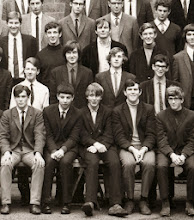
I argue the case in the book True North that the tradition of inventive manufacturing up here is alive and well. The story of the late Jimi Heselden is an example which I would like to add to future editions: a charismatic inventor who used his mining redundancy after the 1984/5 strike to set up a hugely-successful business making his Bastion gabions which defend NATO bases and hold back floodwaters all over the world. He also illustrated another argument which I try to make - that many of the industrialists were great philanthropists too, a tradition obscured in both social history and - especially - fiction by the dramatic struggle of the workers against less enlightened employers. I don't mean to plug my operations generally, but I recently tried to make this point on Comment is Free on the Guardian's website - see www.guardian.co.uk/commentisfree/2010/oct/17/life-lesson-jimi-heselden - after attending Heselden's funeral, held at his factory. The thread was interestingly sympathetic.
Anyway, here are a few books relating to this subject. First, from the very non-industrial paradise of the Hambleton Hills, comes Robert Thompson, the Mouseman of Kilburn by Peter Thompson (Dalesman 1979) which tells the story of the famous woodcarver whose mice delight children (and others) who hunt them down in churches and other places where Mousey's work is to be found. The skill is what normally excites people about Thompson, but I also admire a man, son of the village joiner, who set up a lasting business and prompted many others to start. I remember doing a Guardian piece about the remarkable cluster of furniture-makers which has grown up around Thirsk, including Antony Gormley's older brother John, sadly deceased, who started the firm of Treske, by Thirsk train station.
 I referred to Sir Titus Salt in my Comment is Free piece, and I have mentioned some of the many, instructive books about him in posts below. Less well-known is Sir James Roberts, who bought and rescued Salt's (and the village of Saltaire) when the mill went bust in 1892. He revived both and is properly remembered by Roberts Park, on the far side of the river Aire from the village. I've got this excellent article from the Yorkshire Journal about him, Silk-hatted Bradford Millionaire by Peggy Hewitt, which she sent me in a photocopy. The YJ was a beautiful and interesting but short-lived production in the 1990s and early 2000s by Smith Settle of Otley.
I referred to Sir Titus Salt in my Comment is Free piece, and I have mentioned some of the many, instructive books about him in posts below. Less well-known is Sir James Roberts, who bought and rescued Salt's (and the village of Saltaire) when the mill went bust in 1892. He revived both and is properly remembered by Roberts Park, on the far side of the river Aire from the village. I've got this excellent article from the Yorkshire Journal about him, Silk-hatted Bradford Millionaire by Peggy Hewitt, which she sent me in a photocopy. The YJ was a beautiful and interesting but short-lived production in the 1990s and early 2000s by Smith Settle of Otley. Finally for now, you can still find excellent bargains at the works outlet shops of Northern businesses. This Factory Shop Guide by Gillian Cutress and Rolf Stricker, who first published it themselves in 1987, is out-of-date now and such things are largely replaced by the internet. But we used it to our advantage, as sweeping velvet curtains bought at a bargain price from the factory shop in Lister's titanic old mills on the hilltop in Manningham, Bradford, remind all visitors to Wainwright Towers.
Finally for now, you can still find excellent bargains at the works outlet shops of Northern businesses. This Factory Shop Guide by Gillian Cutress and Rolf Stricker, who first published it themselves in 1987, is out-of-date now and such things are largely replaced by the internet. But we used it to our advantage, as sweeping velvet curtains bought at a bargain price from the factory shop in Lister's titanic old mills on the hilltop in Manningham, Bradford, remind all visitors to Wainwright Towers.

No comments:
Post a Comment